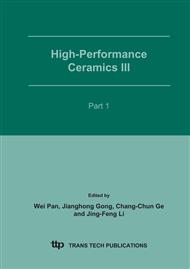p.95
p.99
p.103
p.107
p.111
p.115
p.119
p.123
p.127
Effect of SrO/BaO Ratio on the Phase Structure of the BSTN Composite Ceramics
Abstract:
The effect of SrO/BaO ratio on the phase structure of the (1-x)BaO.xSrO.0.7TiO2.0.3Nb2O5 composite ceramics was investigated by XRD and SEM. The results showed that the SrO/BaO ratio increased in the perovskite phase and kept almost constant in the tungsten bronze phase as the content of SrO increased in the composite system. The constant SrO/BaO ratio in the tungsten bronze phase was about 0.667. The crystal lattices of the perovskite phase in the composite system were larger and smaller respectively than that in pure (1-x)BaO.xSrO.TiO2 system when SrO/BaO ratio were respectively <0.667 and >0.667. The crystal lattices of the perovskite phases in both systems showed the same crystal lattices when SrO/BaO = 0.667. Affected by the SrO/BaO ratio required in the tungsten bronze phase in composite system, the contents and average grain size of the perovskite phase decreased, while the content of tungsten bronze phase increased as the SrO/BaO ratio increased.
Info:
Periodical:
Pages:
111-114
Citation:
Online since:
February 2007
Authors:
Keywords:
Price:
Сopyright:
© 2005 Trans Tech Publications Ltd. All Rights Reserved
Share:
Citation:


